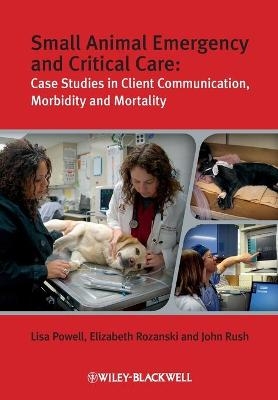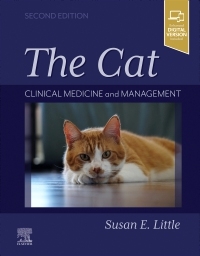
Small Animal Emergency and Critical Care
Wiley-Blackwell (Verlag)
978-1-4051-6752-9 (ISBN)
Small Animal Emergency and Critical Care: Case Studies in Client Communication, Morbidity and Mortality provides a unique opportunity to learn from real-life case examples. Presented as a collection of short case studies, the book examines a wide range of situations likely to arise in emergency practice. The approach is modeled on the Morbidity and Mortality Conferences which were first established as a training and educational tool for medical doctors. They have now been successfully adopted in veterinary medicine as a forum for case review and learning opportunities, encouraging thorough review from different perspectives.
Each chapter presents a real case, and highlights the pitfalls that both novice and experienced veterinarians can encounter. A key theme of the book is on communication issues. Owner perspectives are discussed, as well as how communications between clinicians and owners can be optimized to allow veterinarians to better meet owner expectations.
The cases were provided by a variety of experienced veterinarians, primarily specialists in veterinary emergency and critical care, as well as other specialties, general practice, universities, and private institutions.
This highly readable book is suitable either to absorb from cover to cover, or for reference to a specific case or situation. It highlights a number of common clinical problems and communication issues that either did or may lead to difficulties in case management, helping you to avoid these situations.
Dr Lisa Powell is a clinical professor at the University of Minnesota Veterinary Medical Center, US. Dr Elizabeth Rozanski and Dr John Rush are clinical professors at Tufts University Cummings School of Veterinary Medicine, US. All three are board-certified Diplomates of the American College of Veterinary Emergency and Critical Care, and have 50 years of emergency and critical care experience between them. The authors have practiced in institutions that provide advanced diagnostic techniques, 24-hour emergency and intensive care medicine, and training of both professional veterinary students and post-doctorate veterinarians seeking specialty certification in veterinary emergency and critical care. Dr Rush is also board-certified in veterinary cardiology, and Dr Rozanski is board-certified in veterinary internal medicine.
Contributor list. Preface.
Part One: Medical and Treatment Errors.
1. Coming Up for Air: When equipment failure can be fatal.
2. Alistair and the UTI: Sometimes antibiotics ARE indicated!
3. Double-Check the RX: How a simple math error cost a dog his life.
4. Holey Chest Tube!: How some inadvertent complications led to a change in standard operating procedure.
5. Count Your Sponges: A simple procedure can sometimes result in disaster.
6. First Off, Do No Harm: Always check tube placement, by many methods!
7. Right is Wrong: An example of a tragic outcome due to unmarked radiographs.
8. Sabrina the Good Witch: The importance of using the correct syringe.
9. Friends in High Places: An illustration of how imperative it is to correctly prepare and administer medications.
10. Midnight: A case describing the consequences of technical complications.
11. Sam and the Muscle Medicine: When you should listen to your gut and not your clients’ wishes.
12. A Shot in the Dark: The importance of discussing all potential complications prior to performing the procedure.
Part Two: Medical Judgment Errors.
13. Another Down Dog: Sometimes things are not as they seem!
14. It HAS to Be Blasto!: Surprise endings.
15. Can You Tap that Cat for Me?: Complications of common procedures.
16. Chief’s Complaint: Always suggest further diagnostics, and consider all differential diagnoses in a patient.
17. But He’s Been Fine!: The importance of assessing thoracic radiographs in patients experiencing blunt force trauma.
18. Would You Like Water with That? A Tale of Two Dogs: The dangers of hypernatremia!
19. The Great Pretender: ALWAYS consider hypoadrenocorticism as a differential diagnosis in dogs with nonspecific symptoms
20. A Lack of Concentration: Another example of how Addison’s disease can masquerade as a disease with a much worse prognosis.
21. Unlucky Lady: Remember to consider ALL possible differentials for your patient!
22. But She Has Heart Disease!: All aspects of a patient’s history should be carefully considered when presenting for an illness.
23. Pennies From Heaven: ALWAYS perform abdominal radiographs in patients presenting with signs of immune-mediated hemolytic anemia!
24. Seeing Red!: All ocular abnormalities should be examined promptly and completely, as irreversible disease may be present.
25. Sepsis the Next Day: An illustration of the importance of analyzing effusions yourself if the results will not be reported the same day, and to ALWAYS look under the tongue of a vomiting cat!
26. Anxious to Breathe: Care must be taken when performing diagnostics on brachycephalic, apprehensive dogs.
27. The Lost Acorn: A complicated case gets more perplexing!
28. The Lost Puppies: How the inexperience of a junior veterinarian caused the demise of two puppies.
29. Don’t Be Too Cavalier: A full abdominal exploratory should always be performed during an abdominal surgical procedure.
30. Too Much Sugar: All causes, pulmonary and extrapulmonary, should be investigated in patients with respiratory distress.
31. Tyler: Dehiscence of enterotomy sites should always be considered as a cause of illness in the 3–5 days following the operative procedure.
32. Whiskers: Immunosuppression from administered medications can result in the development of secondary infections.
33. Would You Like Some Salt?: The importance of monitoring fluid therapy.
34. Bambi?: Things to think about when coming into contact with wild animals.
35. The Big C: The dangers of making a pathologic diagnosis without obtaining a biopsy.
36. To Stent or Not to Stent: New technology isn’t always the answer.
37. It Isn’t Asthma?: Noting when it is important to look past the suspected client situation and focus on the patient.
38. Hoping History Doesn’t Repeat: An Illustration of the importance of good history taking.
Part Three: Lessons in Client Communication.
39. Not All Albumins are Equal: When transfusing nonautologous fluids, possible allergic reactions should always be considered and discussed with the client prior to administration.
40. Believing the Client: Listen to the client! They know their pets the best!
41. But I Thought He Would Be Fine?: The importance of communication about prognosis and risk—junior clinician errors.
42. If It’s Not in the Medical Record, Did It Happen?: The importance of a medical director addressing any and all client concerns.
43. Hemangiosarcoma is Bad: Failure to completely evaluate patients can result in a misdiagnosis.
44. The Internet Can Be a Dangerous Thing: One must take into consideration the availability of information on the internet, whether it be true or not, when discussing disease diagnosis and treatment.
45. Is there Some “Wiggle” Room?: An illustration of how essential it is to offer a variety of options to clients.
46. But CPCR Was Successful!: Clear, timely communication about changes in patient status.
47. Rosie and the Platelets: Novel therapies require a firm discussion of risk and benefit.
48. The Receptionist’s Dog: Family and friends’ pets can be particularly stressful for clinicians.
49. We’ll Take Good Care of Maxwell!: Unexpected deterioration of a pet after admission.
50. A Diagnosis to Stand By: A case highlighting why things are not always as they seem.
51. The Confused Setter: Making sure that all presenting clinical complaints are addressed.
52. Tasty Fungi: Working within financial constraints when the disease and prognosis are unknown.
53. Watch What You Write!: A lesson on how to always be professional
54. But She was just Vomiting!: The importance of organization in the midst of chaos.
55. Peroxide Puppy: A case discussing the potential concerns of phone advice.
56. Too Tight!: An illustration of possible complications associated with bandage placement.
57. What Was That Popping Sound?: What to do when a routine procedure goes wrong.
Part Four: Communication Issues between Colleagues and Hospital Staff.
58. Bandit: A case documenting stresses around the holidays, and illustrating different clinical approaches.
59. Check the Medicines: A case describing a very busy day, with an inadvertent distribution of the wrong medications.
60. Cricket and the Insidious Radiograph: Understanding the right and wrong ways to teach and learn.
61. Go Team!: Highlighting the role of experienced technicians in management of cases.
62. Not Just Another Blocked Cat: Outlining conflict between client cost constraints and clinician wishes.
63. Whose Fault?: Highlighting communication between a primary care hospital and an emergency clinic.
64. Shelby and the Needles: What to do when a situation has changed dramatically since the last physical examination.
65. Slow and Easy: The problems of “selling” an unfamiliar procedure to a client.
66. The Bandage: An example of noncollegial behavior.
67. We’ll See What the Blood Work Shows: The importance of timely client communication.
68. What Antibiotic is Best?: Highlighting communication issues between senior veterinary clinicians.
69. Molly and the Chicken Bone: A case outlining the importance of reevaluating patients referred for a second opinion.
70. Know the Nodes: Why physical examination is so important.
71. Nancy’s Neck Pain: A case outlining why a specialist may be helpful.
Appendix: How to Set Up Your Own Morbidity and Mortality Conference.
Index.
| Erscheint lt. Verlag | 24.9.2010 |
|---|---|
| Verlagsort | Hoboken |
| Sprache | englisch |
| Maße | 174 x 245 mm |
| Gewicht | 508 g |
| Themenwelt | Veterinärmedizin ► Kleintier |
| ISBN-10 | 1-4051-6752-1 / 1405167521 |
| ISBN-13 | 978-1-4051-6752-9 / 9781405167529 |
| Zustand | Neuware |
| Informationen gemäß Produktsicherheitsverordnung (GPSR) | |
| Haben Sie eine Frage zum Produkt? |
aus dem Bereich


